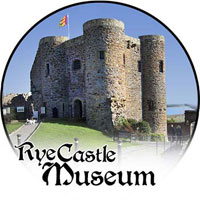The History of the Cinque Ports
There is much controversy about the origin of the Cinque Ports (pronounced ‘sink’, not as in French) but the organisation that we recognise dates back to the 11th Century, during the reign of Edward the Confessor.
It was started by the ports Hastings, Romney, Hythe, Dover and Sandwich for mutual protection and trade. Edward the Confessor’s arrangements with these ports on the South East coast were continued by Harold and William the Conqueror.
Rye and Winchelsea became ’limbs’ of the Head Port of Hastings in the second half of the 12th Century. They were incorporated as ‘Antient Towns’, which meant that they were already long established and of considerable importance. Before Henry II died in 1189, he conferred on them the same privileges as were enjoyed by the original members of the Cinque Ports Federation.
The privileges were in exchange for services; the towns which formed the Confederation supplied ships and seamen for a set number of days per year and in times of trouble, The privileges they received in return (legalised by Royal Charter in 1278) enabled the Cinque Port towns to be exempted from many taxes, to trade wherever they wished and to hold their own courts.
The ‘Antient’ Towns and Limbs
The importance of Rye and Winchelsea and the decline of Hastings elevated them to become Cinque Ports and Head Ports in their own right in the 14th Century although this does not seem to have been marked by any special event or legal formality. In typically English fashion the name of the Confederation was not changed, but continued under the somewhat cumbersome title of the ’Five Ports and Two Ancient Towns’.
Apart from the five ports and the two ancient towns, seven other members were added to the Confederation as Limbs of the other towns. These are Lydd (Limb of New Romney), Folkestone, Faversham and Margate (Limbs of Dover), Deal and Ramsgate (Limbs of Sandwich) and Tenterden (Limb of Rye).
The coat of arms of the Cinque Ports first appeared in 1305, the second amongst the earliest English known heraldic emblems. It even pre-dates London’s the coat of arms. It displays three ships’ hulls and three lions passant guardant joined to them, all in gold.
Serving the King
In 1229 Rye supplied five ships for the King out of the Confederation’s total of fifty seven. In 1337 the Hundred Years War began and the ships of the Cinque Ports were vital to the defence of England and for carrying the army to France.
In 1415 the Confederation fleet transported Henry V and an army of ten thousand to Harfleur, where they subsequently won the Battle of Agincourt.
Although the main duty of the Confederation was defence of the realm and providing ships for the Crown, the Cinque Ports also organised and supplied Bailiffs to the Yarmouth Herring Fair, an annual event which continued until the late seventeenth century. . There were often clashes between the men of Rye and Winchelsea and the men of Yarmouth who resented the privileges held by the Cinque Ports towns.
Decline of the Ports
The decline of the ports dates from the late 15th century when changing ways of warfare made it necessary to have a more permanent marine force and the consequent larger ships were too big for the harbours, which had begun to silt up.
Despite the reduced strategic and tactical importance of the Cinque Ports fleet, the ports remained commercially active. One Rye seaman accompanied Drake on his voyage around the world.
The Ports were asked by Queen Elizabeth to provide ships for the Spanish Armada and in 1588 Rye, with its limb, Tenterden, produced–at twenty days notice–a ship of sixty tons called the William, a feat reflecting its relative prosperity at the time. By the end of the sixteenth century a professional navy, forerunner of the modern Royal Navy, was established but the Cinque Ports had begun on a slow decline.
Warden of the Cinque Ports
The Lord Warden of the Cinque Ports is a ceremonial official in the United Kingdom. The post dates from at least the 12th century but may be older.
The title is one of the higher honours bestowed by the Sovereign and has often been held by members of the Royal Family or Prime Ministers, especially those who have been influential in defending Britain at times of war.The Duke of Wellington (also once MP for Rye), Winston Churchill and the Queen Mother are three examples.
The Legacy
Today only Rye and Dover remain as true ports and Ramsgate has ferries to the Continent. However, by providing ships and men for the Royal Fleet for some 400 years they laid the foundations of England’s maritime power, and their ceremonial importance–at Coronations for example– lasts to this day.
Useful Links
Here are some links to other sites with useful information and illustrations concerning the Cinque Ports. These in turn will direct you to sites about each of the former ports and limbs individually. Happy browsing!
The Confederation of the Cinque Ports Official Website
‘In addition to information about the origins and history of the Confederation we include details of the current organisation and its activities. There are links to other websites providing more detailed information for visitors to the individual towns of the Confederation.’
Village Net
Lots of useful information plus a map, translations to terms used in the Charter and links to all the towns and villages referenced.
